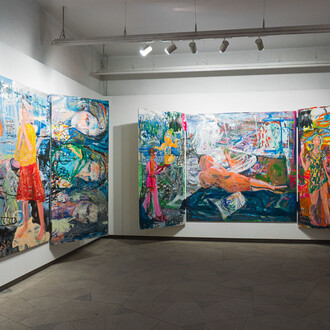The title of the exhibition refers to the game of chess: zugzwang is a situation in which a player is placed at a disadvantage simply because they are forced to make a move. A player is said to be in zugzwang when every legal move available only worsens their position.
This concept also alludes to an implicit intellectual struggle with the personified painting itself – a confrontation where one is compelled to act, even when all possible actions seem destined to fail.
In Zugzwang, the artist explores the digital nature of images and their transformation across media. He investigates the impact of digital technologies on perception and thought, both of which have taken on a screen-like, fragmented quality shaped by the relentless flow of visual information. By using secondary material – sourced from the internet and press – as “technologically processed” imagery that often becomes a kind of “new nature” in contemporary painting, the artist aims to reveal the political and social subtexts, psychological traumas, and issues of collective memory hidden beneath surface visuals.
Mantas Platūkis’s ambivalent system of motif selection reveals how public imagery often conceals the meanings encoded within it – each new viewing allows for reinterpretation. Technology is not only transforming visual culture but also eroding trust in images. In Platūkis’s work, digital visuals “stripped of context” become the raw, plastic material of painting: through transformation, they acquire a new visual context. Within this framework, the term zugzwang becomes a symbolic metaphor for a state of constant strategic movement – signifying not only the artist's inevitable move along the path of creation, but also a move away from what was familiar.
Mantas Platūkis is a painter of the younger generation based in Vilnius. His artistic practice centres on the evolution of technical images, which he analyses through painting. He works with visuals sourced from a range of media – photographs, reproductions, magazines, film stills, and Polaroids – treating them as secondary material. This material, detached from its original context, appears in his works as a form of abstract concreteness – a symbol of a fact that, blurred and stretched by time or memory, has shifted in meaning and form. This interplay of ambiguity and distortion results in symbolic images forcibly severed from their origins. Platūkis’s painterly investigations echo the dilemmas of the contemporary world – his works reflect an effort to understand the transformations, uncertainties, and growing pains of both his generation and the times we live in.
















